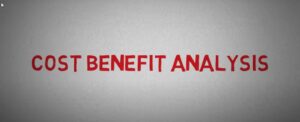Cost-Benefit Analysis is a powerful tool that helps businesses make informed decisions by evaluating a project’s potential costs and benefits. It is a systematic approach that allows companies to weigh a decision’s financial and non-financial implications before investing resources. By comparing the costs and benefits of a proposal, businesses can determine if the benefits outweigh the costs. They can identify if the project is worth undertaking. In this blog post, we’ll discuss the importance, the steps involved in conducting it, and then its various applications in business.
Steps in Conducting a Cost-Benefit Analysis

Before anything else, it’s important to note that while cost-benefit analysis is a helpful tool, it is not a perfect process. It may not consider all the externalities or hidden costs and benefits that may arise later. The best approach is to perform it as an ongoing process also be critical of the results obtained.
Identifying the Costs and Benefits
The first step in conducting a Cost-Benefit Analysis is to identify all the costs and benefits associated with a project or decision. This includes direct and indirect expenses and short-term and long-term benefits. It’s important to consider all relevant costs and benefits and to be as comprehensive as possible.
Assigning monetary values to the costs and benefits
Once you identify all the costs and benefits, they need to be given monetary values. This allows for a direct comparison of costs and benefits and helps to determine the proposal’s net benefit or net cost.
Comparing the Costs and Benefits-
With the costs and benefits assigned to monetary values, it’s possible to compare them and determine the proposal’s net benefit or net cost. This can be done by subtracting the total costs from the total benefits.
Determining the net benefit or net cost
The net benefit or net cost is the difference between the total costs and the total benefits. A positive net benefit indicates that the benefits outweigh the costs, while a negative net benefit suggests that the costs outweigh the benefits.
Assessing the risk and uncertainty of the costs and benefits
The final step is to evaluate the risk and uncertainty associated with the costs and benefits. This includes identifying potential risks that could impact the costs or benefits and assessing the likelihood of these risks occurring. Additionally, it’s essential to consider any uncertainties that may impact the costs or benefits and how they might affect the proposal’s net benefit or net cost.
Applications of Cost-Benefit Analysis

Cost-Benefit Analysis is a versatile tool that entrepreneurs can apply in various contexts. While it is commonly used in the business world for making investment and project decisions, you can also apply it in other areas such as public policy, environmental impact analysis, and product development. This section will discuss some of the critical applications of Cost-Benefit Analysis and how it can then be used to make informed decisions in different scenarios.
Capital Budgeting
CBA can evaluate potential investments in long-term projects. This may include equipment purchases, expansion projects, and new product development. By comparing the costs and benefits of a project, businesses can determine if the investment is worth the potential returns.
Investment Analysis
Business professionals use this to evaluate different projects or assets’ potential return on investment (ROI). By comparing the costs of an investment to the expected benefits, businesses can then determine if an investment is likely to be profitable.
Public Policy Decisions
Business may use this to evaluate the costs and benefits of different policy options. This can also include assessing the costs and benefits of various infrastructure projects, social programs, or regulations.
Environmental Impact Analysis
Companies use Cost-Benefit Analysis to evaluate the ecological impacts of different projects or policies. Businesses and policymakers can determine the net benefit of options by comparing the costs of environmental degradation.
Cost Benefit Analysis on Product Development
Business can use this to evaluate the costs and benefits of different product design options. Businesses can then determine the most cost-effective product design by comparing the costs of different materials, production processes, and features with the expected benefits.
Conclusion

Cost-Benefit Analysis is a valuable tool that helps businesses make informed decisions. It helps in evaluating the costs and benefits of a project or investment. Companies can then determine if a proposal is worth undertaking by identifying all relevant costs and benefits or assigning monetary values. They can also compare them, determine the net benefit or net cost, and assess the risk and uncertainty.
You can apply Cost-Benefit Analysis in various contexts, including capital budgeting and investment analysis. You can also use this on public policy decisions, environmental impact analysis, and product development. It’s important to remember that it is not a perfect method and should be used in conjunction with other methods. By following the steps outlined in this blog post and being critical of the results obtained, businesses can make better-informed decisions and increase their chances of success.